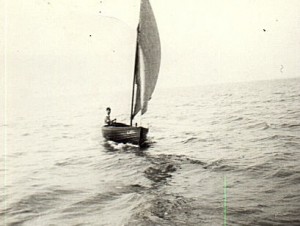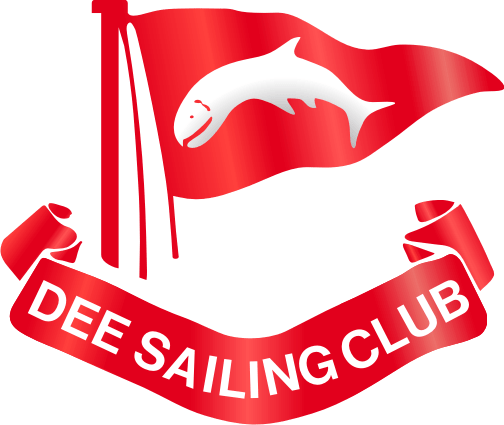The Dee Sailing Club’s formation dates from 30th January 1909, when a meeting was held in the Hotel Victoria to discuss the formation of a sailing club to “encourage amateur boat racing and sailing on the River Dee and Irish Sea”. It was agreed the name of the club would be “The Heswall Sailing Club” and in 1912 it was changed to “The Dee Sailing Club”. The first Commodore was Capt. G.H.Mathias and the club burgee was a salmon on a red background which was changed to a leaping salmon in 1952.
The first club house was built on the corner of Banks Road opposite Shelldrake Restaurant. The following house rules were displayed on the notice board:
(i) Not more than four members are allowed to sleep in the club house until extended.
(ii) Members may book beds in advance, with the secretary.
(iii) Bedrooms only to be used for sleeping and dressing.
The sleeping accommodation was required as some members travelled by train to Heswall Station and wished to stay for a weekend or longer periods.
During the First World War there was little activity in the club and in 1920 they received notice to quit the site. The members decided to move to the opposite corner of Banks Road to the site of the now Shelldrake Restaurant where the club house was situated until the move to Thurstaston in 1982.
In 1927 a new member, Alec Martin won the Low Challenge Cup sailing Cariad, presented by Harold Lowe. This is the oldest of the club’s present day trophies.
In 1934 a new committee was formed with Archie Lane as Commodore and it was decided to build a new club house which is now part of the Shelldrake Restaurant. During the next five years the club expanded rapidly with several extensions to the club house.
In 1938 when Eugene Brunning was Commodore there was a major expansion with a new clubhouse and the existing clubhouse became the changing rooms and bar.
In 1937 Harry Hiscocks joined as a junior member and bought the first 14ft sailing dinghy from Dick Evans.

Harry Hiscocks in his 14ft sailing dinghy
It was hoped to form a class of these boats; sadly there were only three of them built. The last surviving one, Hariet, was sailed for many years by Charles and Stan Massey, winning the Coronation race, amongst others. Stan, after the death of Charles, gave the boat to the Liverpool Maritime Museum as an example of a Heswall built boat.
In the pre war years, handicap races were held. The handicaps varying with the wind strength. One of the courses was: Starting line opposite the clubhouse, Dawpool, Forhwests, targets buoy, Finishing Line, all buoys to starboard. As the majority of boats were cruisers, the Commodores Cruise included naval manoeuvres with pre-coded flag instructions to indicate the manoeuvres to be carried out.
On one occasion the commodore visited each member of the fleet for a drink at lunch time with the inevitable result that he was unable to row back to the Flagship.

Mr Brummings Yacht ‘Pipha’ showing Mr & Mrs Brummings, Alf Daleman and a very young Harry Hiscocks!
During the Second World War the majority of the cruisers were requisitioned by the Royal Navy and post war the club fleet had to be built up with small handicap boats or sailing dinghies. An order was placed for six 12ft Nationals but before these were delivered a new dinghy called a Firefly was announced but in order to obtain a license to buy one, it was necessary to enter the trials for the Olympic Games to be held in Britain in 1948. Six boats were ordered by the Dee, West Kirby and Royal Mersey. After the trials at the individual clubs the North West trials were sailed in the Mersey. Peter Brett from the Dee and Peter Scott who had missed the southern trials, represented the North West in the final trials on the South Coast. Peter Scott won the right to represent Great Britain. A young Paul Elvstrom won the Gold Medal.
In immediate post war years Alec Martin sailing Scott and Arthur Vernon sailing Cyanne both ex One-raters, and Michael Shillaker crewing for his father in Petrel raced in the handicap races. John Mathews and Mike Meakin were alternating winners in the 12ft National Class and John Peters and Harry Hiscocks in the Firefly Class.
In 1953 when Harry Hiscocks was Commodore it was decided to build the first post war extension to the clubhouse. This involved an extension to the bar and changing rooms and connection to the main drains, installation of a hot water system and an open fire in the main club room. This included hot and cold showers for the men. Although this did not include the ladies, they had been given full access to the club premises before the war which was well in advance of any other local clubs and which helped to encourage a family atmosphere.
During the 1950s the main addition to the club fleets were the GPs. This proved a very successful class and quickly outnumbered the other classes. In 1960 orders were placed for the first Hilbres by Mike Shillaker, John McFarland, Ken Maxwell, Harry Hiscocks and Fred Hutchence. This became the main class during the sixties and seventies and becoming the largest fleet of Hilbres in the country.
In 1960 when John Peters was commodore plans were put in hand for extending the club house. This included a starters box with provision for firing guns. The outer distance mark can still be seen today on the bank. Unfortunately it could not be used for long due to the silting at Heswall and the starting line had to be moved down river. One of the notable Commodores during the sixties was Jake Sanders who cut short a Naval career to run his family business. The boatman at the time was Charlie Lewis who would not take orders from anyone but Jake.
The sixties also saw the club with a fleet of Hornets which were berthed at Sally’s Cottage for a while after sailing at Heswall became impractical and before the club had moved to Thurstaston. Chris Weston, John and Bob Ogle, Colin Furber, Jimmy Gwyther, and all sailed Hornets in this period. Most of them had moved from West Kirby SC.
During the seventies the mooring trots for Hilbres were laid at Thurstaston and it became inevitable that the clubhouse would have to move there although there was a vociferous minority against the move. Michael Potts was the Commodore at the time and he was responsible for drawing up the plans and arranging the finance. Chris Weston was Commodore in 1981/2 and was responsible for building the new clubhouse.
Three of the most successful helmsmen in the Hilbres during the seventies were Colin Trantom, Mike Posstlethwaite and John Hancox. During the eighties fleets of 505s, Darts and Scorpions were built up and the cruising fleet flourished with boats making extended cruises to Ireland, the Isle of Man and Scotland.
In the early eighties a fleet of 505s moved from West Cheshire, a fleet of Scorpions started turning out 5-6 boats for racing and the first Catamaran, a Dart 18 started sailing at Dee In the hands of Bionic Barry Arnisson. Within 3 years a fleet of about 20 Darts were established with regular turnouts of 10-12 cats racing from Easter through to the end of October. In 1985 three Darts travelled to the European championships at Lake Garda , with Gareth Owen and Steve Coterall finishing second out of a fleet of over 180 boats from all over Europe and South Africa . They later went on to win the European Championships in Holland the following year. The Dart fleet regularly travelled all over Europe with several cats taking part in European Championships in Portugal, France, Germany, Switzerland and Holland . Some 18 years later Gareth Owen became Dart World Champion after winning the championships in New Caladonia in the South Pacific in 2003 and had a second in the 2006 World Championships in East London SA.
In 2000 in the hands of Tony Marston as Commodore the club went from strength to strength, with his determination to get younger members joining and sailing at Dee. He established a Mirror and Optimist fleet and had racing on both the tide and marine lake. Fleets of more than 10 Oppies can now be seen regularly on Saturdays on the marine lake crewed by children between 7 and 14 years of age.
Thanks are due to Harry Hiscocks and Roger Sanders for compiling this potted history.
